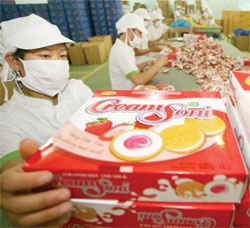Lantern shines on growth path
 Prime Minister Nguyen Tan Dung last week came closer to finalising 2012’s overall prime target, which is to “continue stabilising the macro-economy, curbing inflation and achieving reasonable growth rate in close combination with ensuring social welfare.”
Prime Minister Nguyen Tan Dung last week came closer to finalising 2012’s overall prime target, which is to “continue stabilising the macro-economy, curbing inflation and achieving reasonable growth rate in close combination with ensuring social welfare.”
“We will not stress too much on reaching a high growth rate. Instead, we will focus on improving the quality of growth,” said Deputy Minister of Planning and Investment Cao Viet Sinh.
Minister and Government Office Chairman Vu Duc Dam said though the government would succeed in curbing inflation this year at 7-8 per cent the target of bridling inflation would be continued next year.
“The government never lacks vigilance about possible high inflation recurring,” Dam told a press conference last week following the government’s monthly economic review meeting. He said an economy with frequent macro-instability and high inflation “cannot attract even local investment, much less foreign investment.”
It is the government’s target that stabilising the macroeconomy and curbing inflation will be persistently continued in some years, so that at the end of its term [2015], Vietnam will have a stable economy which will lay firm groundwork for the following years’ development.
The MPI has submitted two scenarios on 2013’s macro-targets to the government. In the first scenario, the GDP will grow 6-6.5 per cent on-year, in which the agro-forestry-fisheries, industrial and construction, and service sectors would grow 2.5-2.8, 6.3-7 and 6.9-7.5 per cent on-year, respectively. Total export turnover would be $124 billion, up 12 per cent on-year.
In the second scenario, the GDP will grow 5.5-6 per cent on-year, in which the agro-forestry-fisheries, industrial and construction, and service sectors would on-year grow 2.4-2.7, 5.7-6.3 and 6.5-7 per cent, respectively. Total export turnover would be $123.2 billion, up 11 per cent on-year.
“The government is determined to curb inflation at a rate lower than or equal to that of 2012, and prune budget overspending to 4.7 per cent of GDP, from 4.8 per cent this year,” Dam said.
However, Prime Minister Dung said for such 2013 targets to come true, the government needed to help local enterprises weather difficulties.
According to HSBC’s Purchasing Managers’ Index™ 2012, conducted on more than 400 manufacturing companies in August and released last week, all the indexes about output, new orders, backlogs of work, stocks of finished goods and employment remained below 50 points, which indicates that the manufacturing economy is declining.
The MPI reported this year’s first eight months saw some 35,500 enterprises dissolve or stop operations, up 7.1 per cent on-year. Also, the index for industrial production (IIP) rose only 4.7 per cent against the same period last year, when the IIP climbed 7.3 per cent on-year.
What the stars mean:
★ Poor ★ ★ Promising ★★★ Good ★★★★ Very good ★★★★★ Exceptional
 Tag:
Tag:
Related Contents
Latest News
More News
- PM urges Ho Chi Minh City to innovate and remain Vietnam’s economic locomotive (November 26, 2025 | 15:29)
- Experts chart Vietnam's digital finance path: high hopes, high stakes (November 14, 2025 | 10:56)
- Vietnam’s seafood imports surge 30 per cent in first 10 months (November 10, 2025 | 19:35)
- Vietnam’s durian exports hit $1 billion milestone (October 30, 2025 | 17:41)
- Beyond borders: Sunhouse and new era of Vietnamese brands on Amazon (October 28, 2025 | 10:46)
- Record-breaking trade fair set to open in Hanoi (October 15, 2025 | 15:59)
- Timber sector seeks solutions to VAT refunds (October 14, 2025 | 18:58)
- Tether explores investment prospects in Vietnam’s digital asset sector (October 10, 2025 | 18:09)
- Vietnamese investors pour nearly $847 million into overseas markets in nine months (October 08, 2025 | 18:42)
- Vietnam amends Law on Civil Aviation to create drive airport investment (October 03, 2025 | 18:29)
























 Mobile Version
Mobile Version